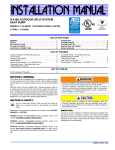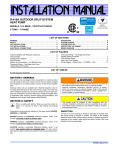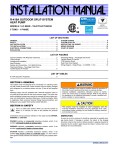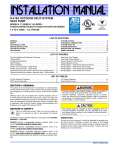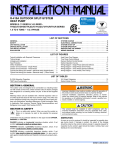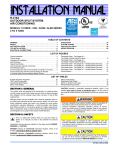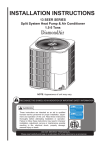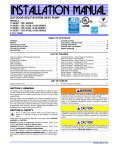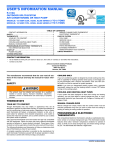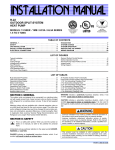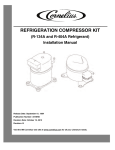Download York 15 SEER - CZE Installation manual
Transcript
INSTALLATION MANUAL TI FI ED T O ARI C ER PL -C RY UN I NI N G G W IT H OI IT TA Y D ON MA N U F A C T U R AS AIR NI ER M C O R-410A OUTDOOR SPLIT-SYSTEM AIR CONDITIONING R RT IF RI I CA T F U I P M EN T O EQ E C A T IO NS I ON S E C 10 S T A NDA R D 2 CERTIFICATION APPLIES ONLY WHEN THE COMPLETE SYSTEM IS LISTED WITH ARI. MODELS: 15 SEER - CZE / AC5B / AL5B SERIES 2 TO 5 TONS LISTED This product was manufactured in a plant whose quality system is certified/registered as being in conformity with ISO 9001. TABLE OF CONTENTS GENERAL . . . . . . . . . . . . . . . . . . . . . . . . . . . . . . . . . . . . . . . . . . . . . . 1 SAFETY . . . . . . . . . . . . . . . . . . . . . . . . . . . . . . . . . . . . . . . . . . . . . . . . 1 UNIT INSTALLATION . . . . . . . . . . . . . . . . . . . . . . . . . . . . . . . . . . . . . 2 INSTALLATIONS REQUIRING TXV . . . . . . . . . . . . . . . . . . . . . . . . . . 4 ELECTRICAL CONNECTIONS . . . . . . . . . . . . . . . . . . . . . . . . . . . . . . 5 EVACUATION . . . . . . . . . . . . . . . . . . . . . . . . . . . . . . . . . . . . . . . . . . .7 SYSTEM CHARGE . . . . . . . . . . . . . . . . . . . . . . . . . . . . . . . . . . . . . . .7 SYSTEM START-UP . . . . . . . . . . . . . . . . . . . . . . . . . . . . . . . . . . . . . .8 WIRING DIAGRAM . . . . . . . . . . . . . . . . . . . . . . . . . . . . . . . . . . . . . .11 LIST OF TABLES R-410A Saturation Properties . . . . . . . . . . . . . . . . . . . . . . . . . . . . . . . . . . . . . . . . 8 15Z24AC Subcooling Charging Chart . . . . . . . . . . . . . . . . . . . . . . . . . . . . . . . . . 9 15Z36AC Subcooling Charging Chart . . . . . . . . . . . . . . . . . . . . . . . . . . . . . . . . . 9 15Z48AC Subcooling Charging Chart . . . . . . . . . . . . . . . . . . . . . . . . . . . . . . . . . 9 15Z60AC Subcooling Charging Chart . . . . . . . . . . . . . . . . . . . . . . . . . . . . . . . . . 9 Diagnostic Label . . . . . . . . . . . . . . . . . . . . . . . . . . . . . . . . . . . . . . . . . . . . . . . . 10 LIST OF FIGURES Typical Installation . . . . . . . . . . . . . . . . . . . . . . . . . . . . . . . . . . . . . . . . . . . . . . . . 2 Tubing Hanger . . . . . . . . . . . . . . . . . . . . . . . . . . . . . . . . . . . . . . . . . . . . . . . . . . . 3 Underground Installation . . . . . . . . . . . . . . . . . . . . . . . . . . . . . . . . . . . . . . . . . . . . 3 Heat Protection . . . . . . . . . . . . . . . . . . . . . . . . . . . . . . . . . . . . . . . . . . . . . . . . . . . 4 Typical Field Wiring . . . . . . . . . . . . . . . . . . . . . . . . . . . . . . . . . . . . . . . . . . . . . . . 5 CFM Selection Board . . . . . . . . . . . . . . . . . . . . . . . . . . . . . . . . . . . . . . . . . . . . . . 5 Single Stage Non-Variable Speed Furnace (Y Connection Only) . . . . . . . . . . . . 6 Non-Variable Speed Furnace (Y1 & Y2 Connection) . . . . . . . . . . . . . . . . . . . . . 6 Typical Variable Speed Furnace/Air Handler Wiring . . . . . . . . . . . . . . . . . . . . . 6 N1AH, F2RP/F2FP, F2RC/F2FC Air Handler and 2-Speed Fan Kit Wiring . . . . . 6 Wiring Diagram . . . . . . . . . . . . . . . . . . . . . . . . . . . . . . . . . . . . . . . . . . . . . . . . . 11 SECTION I: GENERAL The outdoor units are designed to be connected to a matching indoor coil with sweat connect lines. Sweat connect units are factory charged with refrigerant for the highest sales volume evaporator plus 15 feet of field supplied lines. Matching indoor coils are available with a thermal expansion valve or an orifice liquid feed sized for the most common usage. The orifice size and/or refrigerant charge may need to be changed for some system combinations, elevation differences, or total line lengths. See tabular data sheet provided in unit literature packet for charge requirements. Refer to Application Data covering “General Piping Recommendations and Refrigerant Line Length” (Part Number 036-61920-001). SECTION II: SAFETY This is a safety alert symbol. When you see this symbol on labels or in manuals, be alert to the potential for personal injury. Understand and pay particular attention to the signal words DANGER, WARNING, or CAUTION. DANGER indicates an imminently hazardous situation, which, if not avoided, will result in death or serious injury. WARNING indicates a potentially hazardous situation, which, if not avoided, could result in death or serious injury. CAUTION indicates a potentially hazardous situation, which, if not avoided may result in minor or moderate injury. It is also used to alert against unsafe practices and hazards involving only property damage. Improper installation may create a condition where the operation of the product could cause personal injury or property damage. Improper installation, adjustment, alteration, service, or maintenance can cause injury or property damage. Refer to this manual for assistance or for additional information, consult a qualified contractor, installer, or service agency. This product must be installed in strict compliance with the enclosed installation instructions and any applicable local, state, and national codes including, but not limited to building, electrical, and mechanical codes. R-410A systems operate at higher pressures than R-22 systems. Do not use R-22 service equipment or components on R-410A equipment. Service equipment Must Be Rated for R-410A. INSPECTION As soon as a unit is received, it should be inspected for possible damage during transit. If damage is evident, the extent of the damage should be noted on the carrier’s delivery receipt. A separate request for inspection by the carrier’s agent should be made in writing. See Local Distributor for more information. 66901 / 035-20393-001 Rev. C (1204) 66901 / 035-20393-001 Rev. C (1204) Requirements For Installing/Servicing R-410A Equipment • • • • • • • Gauge sets, hoses, refrigerant containers, and recovery systems must be designed to handle the POE type oils and the higher pressures of R-410A. Manifold sets should be 800 PSIG high side and 250 PSIG low side with 550 PSIG low side retard. All hoses must have a 700 PSIG service pressure rating. Leak detectors should be designed to detect HFC refrigerant. Recovery equipment (including refrigerant recovery containers) must be specifically designed to handle R-410A. Do not use an R-22 TXV. A liquid-line filter drier is required on every unit. The outdoor unit must have sufficient clearance for air entrance to the condenser coil, for air discharge, and for service access. See Figure 1. NOTE: For multiple unit installations, units must be spaced a minimum of 18 inches apart. (coil face to coil face.) If the unit is to be installed on a hot sun exposed roof or a black-topped ground area, the unit should be raised sufficiently above the roof or ground to avoid taking the accumulated layer of hot air into the outdoor unit. Provide an adequate structural support. ADD-ON REPLACEMENT/RETROFIT The unit should be installed in accordance with all National, State, and Local Safety Codes and the limitations listed below: When this unit is being used as a replacement for an R-22 unit, it is required that the outdoor unit, indoor coil, and metering device all be replaced. Line-set change out is also recommended. The following steps should be performed in order to insure proper system operation and performance. 1. Limitations for the indoor unit, coil, and appropriate accessories must also be observed. 1. Change-out of the indoor coil to an approved R-410A coil with the appropriate metering device. 2. Only variable speed air handlers or variable speed furnaces should be used with these models. 2. 3. The outdoor unit must not be installed with any duct work in the air stream. The outdoor fan is the propeller type and is not designed to operate against any additional external static pressure. Change-out of the line-set when replacing an R-22 unit with an R-410A unit is highly recommended to reduce cross-contamination of oils and refrigerants. 3. If change-out of the line set is not practical, then the following precautions should be taken. LIMITATIONS 4. The maximum and minimum conditions for operation must be observed to ensure a system that will give maximum performance with minimum service. 5. The unit should not be operated at outdoor temperatures below 60° F without an approved low ambient operation accessory kit installed. 6. The maximum allowable line length for this product is 75 feet. 7. Indoor evaporator coil orifice must be removed prior to the installation of a factory supplied balanced port TXV kit. SECTION III: UNIT INSTALLATION LOCATION Before starting the installation, select and check the suitability of the location for both the indoor and outdoor unit. Observe all limitations and clearance requirements. • Inspect the line set for kinks, sharp bends, or other restrictions, and for corrosion. • Determine if there are any low spots which might be serving as oil traps. • Flush the line set with a commercially available flush kit to remove as much of the existing oil and contaminants as possible. • Install a suction line filter-drier to trap any remaining contaminants, and remove after 50 hours of operation. 4. If the outdoor unit is being replaced due to a compressor burnout, then installation of a 100% activated alumina suction-line filter drier is required, in addition to the factory installed liquid-line drier. Operate the system for 10 hours. Monitor the suction drier pressure drop. If the pressure drop exceeds 3 psig, replace both the suction-line and liquid-line driers. After a total of 10 hours run time where the suction-line pressure drop has not exceeded 3 psig, replace the liquid line drier, and remove the suction-line drier. Never leave a suction-line drier in the system longer than 50 hours of run time. THERMOSTAT NEC CLASS 1 WIRING TO INDOOR BLOWER NEC CLASS 2 WIRING WEATHERPROOF DISCONNECT SWITCH 48” OVERHEAD CLEARANCE TO COIL SEAL OPENINGS WITH PERMAGUM OR EQUIVALENT 24” SERVICE ACCESS CLEARANCE 18” FRONT & SIDES NOTE: ALL OUTDOOR WIRING MUST BE WEATHERPROOF FIGURE 1: Typical Installation 2 Unitary Products Group 66901 / 035-20393-001 Rev. C (1204) GROUND INSTALLATION The unit may be installed at ground level on a solid base that will not shift or settle, causing strain on the refrigerant lines and possible leaks. Maintain the clearances shown in Figure 1 and install the unit in a level position. Normal operating sound levels may be objectionable if the unit is placed directly under windows of certain rooms (bedrooms, study, etc.). NOTE: Using a larger than specified line size could result in oil return problems. Using too small a line will result in loss of capacity and other problems caused by insufficient refrigerant flow. Slope horizontal vapor lines at least 1" every 20 feet toward the outdoor unit to facilitate proper oil return. PRECAUTIONS DURING LINE INSTALLATION 1. Install the lines with as few bends as possible. Care must be taken not to damage the couplings or kink the tubing. Use clean hard drawn copper tubing where no appreciable amount of bending around obstruction is necessary. If soft copper must be used, care must be taken to avoid sharp bends which may cause a restriction. When installing units on a roof, the structure must be capable of supporting the total weight of the unit, including a pad, lintels, rails, etc., which should be used to minimize the transmission of sound or vibration into the conditioned space. 2. The lines should be installed so that they will not obstruct service access to the coil, air handling system, or filter. 3. Care must also be taken to isolate the refrigerant lines to minimize noise transmission from the equipment to the structure. UNIT PLACEMENT 4. The vapor line must be insulated with a minimum of 1/2" foam rubber insulation (Armaflex or equivalent). Liquid lines that will be exposed to direct sunlight and/or high temperatures must also be insulated. Isolate the unit from rain gutters to avoid any possible wash out of the foundation. ROOF INSTALLATION 1. Provide a base in the pre-determined location. 2. Remove the shipping carton and inspect for possible damage. 3. Compressor tie-down bolts should remain tightened. 4. Position the unit on the base provided. Tape and suspend the refrigerant lines as shown. DO NOT allow tube metal-to-metal contact. See Figure 2. 5. Use PVC piping as a conduit for all underground installations as shown in Figure 3. Buried lines should be kept as short as possible to minimize the build up of liquid refrigerant in the vapor line during long periods of shutdown 6. Pack fiberglass insulation and a sealing material such as permagum around refrigerant lines where they penetrate a wall to reduce vibration and to retain some flexibility. 7. See application part number 036-61920-000 for additional piping information. LIQUID LINE FILTER-DRIER The air conditioning unit’s copper spun bi-flow filter/dryer is located on the liquid line. NOTE: Replacements for the liquid line drier must be exactly the same as marked on the original factory drier. See Source 1 for O.E.M. replacement driers. Sheet Metal Hanger Failure to do so or using a substitute drier or a granular type may result in damage to the equipment. Liquid Line Incorrect Apply with Models Filter-Drier Source 1 Part No. CZE / AC5B / AL5B 029-22195-000 All Tape Correct Insulated Vapor Line PIPING CONNECTIONS FIGURE 2: Tubing Hanger TO INDOOR COIL This system uses R-410A refrigerant which operates at higher pressures than R-22. No other refrigerant may be used in this system. Gauge sets, hoses, refrigerant containers, and recovery systems must be designed to handle R-410A. If you are unsure, consult the equipment manufacturer. Never install a suction-line filter drier in the liquid line of an R-410A system. Failure to follow this warning can cause a fire, injury or death. The outdoor condensing unit must be connected to the indoor evaporator coil using field supplied refrigerant grade copper tubing that is internally clean and dry. Units should be installed only with the tubing sizes for approved system combinations as specified in tabular data sheet. The charge given is applicable for total tubing lengths up to 15 feet. See Application Data Part Number 036-61920-000 for installing tubing of longer lengths and elevation differences. Unitary Products Group LIQUID LINE PVC TO OUTDOOR UNIT INSULATED CAP VAPOR LINE CONDUIT FIGURE 3: Underground Installation PRECAUTIONS DURING BRAZING OF LINES All outdoor unit and evaporator coil connections are copper-to-copper and should be brazed with a phosphorous-copper alloy material such as Silfos-5 or equivalent. DO NOT use soft solder. The outdoor units have reusable service valves on both the liquid and vapor connections. The total system refrigerant charge is retained within the outdoor unit during shipping and installation. The reusable service valves are provided to evacuate and charge per this instruction. Serious service problems can be avoided by taking adequate precautions to ensure an internally clean and dry system. 3 66901 / 035-20393-001 Rev. C (1204) Dry nitrogen should always be supplied through the tubing while it is being brazed, because the temperature is high enough to cause oxidation of the copper unless an inert atmosphere is provided. The flow of dry nitrogen should continue until the joint has cooled. Always use a pressure regulator and safety valve to insure that only low pressure dry nitrogen is introduced into the tubing. Only a small flow is necessary to displace air and prevent oxidation. PRECAUTIONS DURING BRAZING SERVICE VALVE Precautions should be taken to prevent heat damage to service valves by wrapping a wet rag around it as shown in Figure 4. Also, protect all painted surfaces, insulation, and plastic base during brazing. After brazing, cool joint with wet rag. This is not a backseating valve. The service access port has a valve core. Opening or closing valve does not close service access port. If the valve stem is backed out past the chamfered retaining wall, the O-ring can be damaged causing leakage or system pressure could force the valve stem out of the valve body possibly causing personal injury. The valve can be opened by removing the plunger cap and fully inserting a hex wrench into the stem and backing out counter-clockwise until valve stem just touches the chamfered retaining wall. Connect the refrigerant lines using the following procedure: 1. Remove the cap and Schrader core from both the liquid and vapor service valve service ports at the outdoor unit. Connect low pressure nitrogen to the liquid line service port. 2. Braze the liquid line to the liquid valve at the outdoor unit. Be sure to wrap the valve body with a wet rag. Allow the nitrogen to continue flowing. Refer to the Tabular Data Sheet for proper liquid line sizing. 3. Carefully remove the rubber plugs from the evaporator liquid and vapor connections at the indoor coil. 6. Protect the vapor valve with a wet rag and braze the vapor line connection to the outdoor unit. The nitrogen flow should be exiting the system from the vapor service port connection. After this connection has cooled, remove the nitrogen source from the liquid fitting service port. 7. Replace the Schrader core in the liquid and vapor valves. 8. Go to “SECTION IV” for TXV installation. 9. Leak test all refrigerant piping connections including the service port flare caps to be sure they are leak tight. DO NOT OVERTIGHTEN (between 40 and 60 inch - lbs. maximum). NOTE: Line set and indoor coil can be pressurized to 250 psig with dry nitrogen and leak tested with a bubble type leak detector. Then release the nitrogen charge. NOTE: Do not use the system refrigerant in the outdoor unit to purge or leak test. 10. Evacuate the vapor line, evaporator, and the liquid line to 500 microns or less. 11. Replace cap on service ports. Do not remove the flare caps from the service ports except when necessary for servicing the system. Do not connect manifold gauges unless trouble is suspected. Approximately 3/4 ounce of refrigerant will be lost each time a standard manifold gauge is connected. 12. Release the refrigerant charge into the system. Open both the liquid and vapor valves by removing the plunger cap and with an allen wrench back out counter-clockwise until valve stem just touches the chamfered retaining wall. See Page 4 "PRECAUTIONS DURING BRAZING SERVICE VALVE". 13. Replace plunger cap finger tight, then tighten an additional 1/12 turn (1/2 hex flat). Cap must be replaced to prevent leaks. Never attempt to repair any brazed connections while the system is under pressure. Personal injury could result. See "System Charge” section for checking and recording system charge. SECTION IV: INSTALLATIONS REQUIRING TXV For installations requiring a TXV, the following are the basic steps for installation. For detailed instructions, refer to the Installation Instructions accompanying the TXV kit. Install TXV kit as follows: FIGURE 4: Heat Protection 1. First, relieve the holding charge by depressing the Schrader valve located in the end of the liquid line. 2. After holding charge is completely discharged, loosen and remove the liquid line fitting from the orifice distributor assembly. Note that the fitting has right hand threads. 3. Remove the orifice from the distributor body using a small diameter wire or paper clip. Orifice is not used when the TXV assembly is installed. 4. After orifice is removed, install the thermal expansion valve to the orifice distributor assembly with supplied fittings. Hand tighten and turn an additional 1/8 turn to seal. Do not overtighten fittings. 5. Reinstall the liquid line to the top of the thermal expansion valve. Hand modify the liquid line to align with casing opening. The evaporator is pressurized. 4. Braze the liquid line to the evaporator liquid connection. Nitrogen should be flowing through the evaporator coil. 5. Slide the grommet away from the vapor connection at the indoor coil. Braze the vapor line to the evaporator vapor connection. After the connection has cooled, slide the grommet back into original position. Refer to the Tabular Data Sheet for proper vapor line sizing. 4 6. Install the TXV equalizer line into the vapor line as follows: a. Select a location on the vapor line for insertion of the equalizer line which will not interfere with TXV bulb placement. b. Use an awl to punch through the suction tube and insert the awl to a depth to achieve a 1/8” diameter hole. Unitary Products Group 66901 / 035-20393-001 Rev. C (1204) 7. Install TXV equalizer line in 1/8” hole previously made in vapor line. Equalizer line should not be bottomed out in the vapor line. Insert equalizer line at least 1/4” in the vapor line. Braze equalizer line making sure that tube opening is not brazed closed. 4. Remove the service access panel to gain access to the unit wiring. Route wires from disconnect through power wiring opening provided and into the unit control box. 5. Install the proper size time-delay fuses or circuit breaker, and make the power supply connections. Dry nitrogen should always be supplied through the tubing while it is being brazed, because the temperature is high enough to cause oxidation of the copper unless an inert atmosphere is provided. The flow of dry nitrogen should continue until the joint has cooled. Always use a pressure regulator and safety valve to insure that only low pressure dry nitrogen is introduced into the tubing. Only a small flow is necessary to displace air and prevent oxidation. SERVICE ACCESS PANEL All connections to be brazed are copper-to-copper and should be brazed with a phosphorous-copper alloy material such as Silfos-5 or equivalent. DO NOT use soft solder. Install the TXV bulb to the vapor line near the equalizer line, using the two bulb clamps furnished with the TXV assembly. Ensure the bulb is making maximum contact. Refer to TXV installation instruction for view of bulb location. In all cases, mount the TXV bulb after vapor line is brazed and has had sufficient time to cool. a. Bulb should be installed on a horizontal run of the vapor line if possible. On lines under 7/8" OD the bulb may be installed on top of the line. With 7/8" OD and over, the bulb should be installed at the position of about 2 or 10 o'clock. b. If bulb installation is made on a vertical run, the bulb should be located at least 16 inches from any bend, and on the tubing sides opposite the plane of the bend. The bulb should be positioned with the bulb tail at the top, so that the bulb acts as a reservoir. c. Bulb should be insulated using thermal insulation provided to protect it from the effect of the surrounding ambient temperature. SECTION V: ELECTRICAL CONNECTIONS GENERAL INFORMATION & GROUNDING CORNER COVER CONTROL WIRING POWER WIRING FIGURE 5: Typical Field Wiring FIELD CONNECTIONS CONTROL WIRING 1. Route low voltage wiring into bottom of control box. Make low voltage wiring connections inside the junction box per Figures 7-9. 2. The complete connection diagram and schematic wiring label is located on the inside surface of the unit service access panel. 3. Replace the corner cover and service access panel that were removed in Steps 2 and 4 of the “Field Connections Power Wiring” section. 4. All field wiring to be in accordance with national electrical codes (NEC) and/or local-city codes. 5. Mount the thermostat about 5 ft. above the floor, where it will be exposed to normal room air circulation. Do not place it on an outside wall or where it is exposed to the radiant effect from exposed glass or appliances, drafts from outside doors, or supply air grilles. 6. Route the 24-volt control wiring (NEC Class 2) from the outdoor unit to the indoor unit and thermostat. NOTE: To eliminate erratic operation, seal the hole in the wall at the thermostat with permagum or equivalent to prevent air drafts affecting the operation of in the thermostat. CFM SELECTION BOARD SETTINGS Check the electrical supply to be sure that it meets the values specified on the unit nameplate and wiring label. Power wiring, control (low voltage) wiring, disconnect switches, and over current protection must be supplied by the installer. Wire size should be sized per NEC requirements. CFM SELECTION BOARD TAP SELECTION D C B A D C B A COOL HEAT ADJ DELAY REMOVE FOR HEAT PUMP All field wiring must USE COPPER CONDUCTORS ONLY and be in accordance with Local, National, Fire, Safety, & Electrical Codes. This unit must be grounded with a separate ground wire in accordance with the above codes. HUMIDISTAT FIGURE 6: CFM Selection Board The complete connection diagram and schematic wiring label is located on the inside surface of the unit service access panel. For proper system operation the CFM Selection Board jumpers must be set properly. FIELD CONNECTIONS POWER WIRING Refer to the Tabular Data Sheet for the recommended air flow settings for each size condensing unit. 1. Install the proper size weatherproof disconnect switch outdoors and within sight of the unit. 2. Remove the screws at the bottom of the corner cover. Slide corner cover down and remove from unit. See Figure 5. Set the cooling speed per the instructions for the air handler or furnace by selecting the correct COOL and ADJ taps. Verify the airflow using the LED display on the CFM selection board. 3. Run power wiring from the disconnect switch to the unit. Unitary Products Group The HUMIDISTAT jumper must also be removed if a dehumidistat is installed. 5 66901 / 035-20393-001 Rev. C (1204) THERMOSTAT VARIABLE SPEED 2 AIR HANDLER C Y1 Y1 Y2 Y2 O O 2 -STAGE AIR CONDITIONER BLK YEL C THERMOSTAT BLU/YEL W X/L R VARIABLE SPEED FURNACE C C Y1 Y1 Y2 Y2 O O 2-STAGE AIR CONDITONER BLK YEL BLU/YEL W X/L RED R 1 X/L X/L R R RED 1 HUM Y HUM W2 Y E W1 W2 G G E G 1 HUMIDISTAT CONTACTS OPEN ON HUMIDITY RISE. HUMIDISTAT JUMPER ON CFM SELECTION BOARD MUST BE REMOVED. 2 Y1, Y2, AND HUM LOCATED ON CFM SELECTION BOARD. FIGURE 7: Typical Variable Speed Air Handler Thermostat Wiring THERMOSTAT VARIABLE SPEED 2 FURNACE C C Y1 Y1 HUMIDISTAT CONTACTS OPEN ON HUMIDITY RISE. HUMIDISTAT JUMPER ON CFM SELECTION BOARD MUST BE REMOVED. FIGURE 9: Typical Previous Generation Variable Speed Furnace Thermostat Wiring 2-STAGE AIR CONDITIONER BLK YEL BLU/YEL Y2 O 1 W1 G O W X/L X/L R R RED 1 HUM Y2/Y W2 E G W1/W G 1 HUMIDISTAT CONTACTS OPEN ON HUMIDITY RISE. HUMIDISTAT INSTALLED? JUMPER MUST BE IN YES POSITION. 2 HUM LOCATED ON CFM SELECTION BOARD. FIGURE 8: Typical Variable Speed Furnace Thermostat Wiring 6 Unitary Products Group 66901 / 035-20393-001 Rev. C (1204) DEHUMIDIFICATION CONTROL 2. Determine indoor coil adjustment from tabular data sheet. A dehumidification control accessory 2HU06700124 may be used with variable speed air handlers or furnaces in high humidity areas. This control works with the variable speed indoor unit to provide cooling at a reduced air flow, lowering evaporator temperature and increasing latent capacity. The humidistat in this control opens the humidistat contacts on humidity rise. To install, refer to instructions packaged with the accessory and Figures 7-9. Prior to the installation of the dehumidification control, the jumper across the HUMIDISTAT terminals on the indoor variable speed air handler or furnace CFM selection board must be removed. 3. Calculate the line charge using the tabular data sheet if line length is greater than 15 feet. During cooling, if the relative humidity in the space is higher than the desired set point of the dehumidification control, the variable speed blower motor will operate at lower speed until the dehumidification control is satisfied. A 40-60% relative humidity level is recommended to achieve optimum comfort. If a dehumidification control is installed, it is recommended that a minimum air flow of 325 cfm/ton be supplied at all times. 4. Total system charge = item 1 + item 2 + item 3. 5. Permanently stamp the unit data plate with the total amount of refrigerant in the system. Use the following subcooling charging method whenever additional refrigerant is required for the system charge. A superheat charging method is not suitable for TXV equipped systems. Refrigerant charging should only be carried out by a qualified air conditioning contractor. Measurement Method If a calibrated charging cylinder or accurate weighing device is available, add refrigerant accordingly. SECTION VI: EVACUATION It will be necessary to evacuate the system to 500 microns or less. If a leak is suspected, leak test with dry nitrogen to locate the leak. Repair the leak and test again. To verify that the system has no leaks, simply close the valve to the vacuum pump suction to isolate the pump and hold the system under vacuum. Watch the micron gauge for a few minutes. If the micron gauge indicates a steady and continuous rise, it’s an indication of a leak. If the gauge shows a rise, then levels off after a few minutes and remains fairly constant, it’s an indication that the system is leak free but still contains moisture and may require further evacuation if the reading is above 500 microns. SECTION VII: SYSTEM CHARGE R-410A refrigerant cylinders are rose colored, and have a dip tube which allows liquid to flow out of the cylinder in the Upright Position. Always charge the system slowly with the tank in the upright position. The factory charge in the outdoor unit includes enough charge for the unit and the highest sales volume evaporator. Some indoor coil matches may require additional charge. See tabular data sheet provided in unit literature packet for charge requirements. Do not leave the system open to the atmosphere. Unit damage could occur due to moisture being absorbed by the POE oil in the system. This type of oil is highly susceptible to moisture absorption. The “TOTAL SYSTEM CHARGE” must be permanently stamped on the unit data plate. Total system charge is determined as follows: 1. Determine outdoor unit charge from tabular data sheet. Unitary Products Group Compressor damage will occur if system is improperly charged. On new system installations, charge system per tabular data sheet for the matched coil and follow guidelines in this instruction. Check flare caps on service ports to be sure they are leak tight. DO NOT OVERTIGHTEN (between 40 and 60 inch - lbs. maximum). Subcooling Charging Method This condensing unit must only be used with the matching thermostatic expansion valve kit listed in the Tabular Data Sheet. This unit must be charged during second-stage (Y1 & Y2) operation only. See Tables 27 for unit specific subcooling charts. For mix matched systems, the recommended subcooling is 10°F 1. Set the system running in the Second-Stage (Y1 + Y2) cooling mode by setting the thermostat at least 6°F below the room temperature. 2. Operate the system for a minimum of 15-20 minutes. 3. Refer to the tabular data sheet for the recommended airflow and verify this indoor airflow (it should be about 400 SCFM per ton). 4. Measure the liquid refrigerant pressure P and temperature T at the service valve. 5. Calculate the saturated liquid temperature ST from Table 1. 6. Subcooling temperature TC = Saturated Temperature (ST) - Liquid Temp (T). Example: The pressure P and temperature T measured at the liquid service port is 360 Psig and 93°F. From Table 1, the saturated temperature for 360 Psig is 109°. The subcooling temperature TC = 109°-93°=16°F Add charge if the calculated subcooling temperature TC in Step 6 is lower than the recommended level. Remove and recover the refrigerant if the subcooling TC is higher than the recommended level. See Table 1 for R-410A saturation temperatures. 7 66901 / 035-20393-001 Rev. C (1204) SECTION VIII: SYSTEM START-UP Maintenance INDICATIONS OF PROPER OPERATION 1. Dirt should not be allowed to accumulate on the outdoor coils or other parts in the air circuit. Clean as often as necessary to keep the unit clean. Use a brush, vacuum cleaner attachment, or other suitable means. 2. The outdoor fan motor is permanently lubricated and does not require periodic oiling. 3. If the coil needs to be cleaned, it should be washed with Calgon Coilclean (mix one part Coilclean to seven parts water). Allow solution to remain on coil for 30 minutes before rinsing with clean water. Solution should not be permitted to come in contact with painted surfaces. 4. Refer to the furnace or air handler instructions for filter and blower motor maintenance. 5. The indoor coil and drain pan should be inspected and cleaned regularly to prevent odors and assure proper drainage. Cooling 1. The outdoor fan should be running, with warm air being discharged from the top of the unit. 2. The indoor blower (furnace or air handler) will be operating, discharging cool air from the ducts. Coils or other parts in the air circuit should be cleaned as often as necessary to keep the unit clean. Use a brush, vacuum cleaner attachment, or other suitable means. 3. The vapor line at the outdoor unit will feel cool to the touch. 4. The liquid line at the outdoor unit will feel warm to the touch. Instructing the Owner Assist owner with processing warranty cards and/or online registration. Review Owners Manual, provide a copy to the owner, and provide guidance on proper operation and maintenance. Instruct the owner or the operator how to start, stop, and adjust temperature setting. The installer should also instruct the owner on proper operation and maintenance of all other system components. IT IS UNLAWFUL TO KNOWINGLY VENT, RELEASE OR DISCHARGE REFRIGERANT INTO THE OPEN AIR DURING REPAIR, SERVICE, MAINTENANCE OR THE FINAL DISPOSAL OF THIS UNIT. WHEN THE SYSTEM IS FUNCTIONING PROPERLY AND THE OWNER HAS BEEN FULLY INSTRUCTED, SECURE THE OWNER’S APPROVAL. TABLE 1: R-410A Saturation Properties 8 TEMP. °F PRESSURE PSIG TEMP. °F PRESSURE PSIG TEMP. °F PRESSURE PSIG TEMP. °F PRESSURE PSIG TEMP. °F PRESSURE PSIG 45 129.70 60 169.60 75 217.40 90 274.10 105 340.50 46 132.20 61 172.60 76 220.90 91 278.20 106 345.30 47 134.60 62 175.50 77 224.40 92 282.30 107 350.10 48 137.10 63 178.50 78 228.00 93 286.50 108 355.00 49 139.60 64 181.60 79 231.60 94 290.80 109 360.00 50 142.20 65 184.60 80 235.30 95 295.10 110 365.00 51 144.80 66 187.70 81 239.00 96 299.40 111 370.00 52 147.40 67 190.90 82 242.70 97 303.80 112 375.10 53 150.10 68 194.10 83 246.50 98 308.20 113 380.20 54 152.80 69 197.30 84 250.30 99 312.70 114 385.40 55 155.50 70 200.60 85 254.10 100 317.20 115 390.70 56 158.20 71 203.90 86 258.00 101 321.80 116 396.00 57 161.00 72 207.20 87 262.00 102 326.40 117 401.30 58 163.90 73 210.60 88 266.00 103 331.00 118 406.70 59 166.70 74 214.00 89 270.00 104 335.70 119 412.20 Unitary Products Group 66901 / 035-20393-001 Rev. C (1204) TABLE 2: 15Z24AC Subcooling Charging Chart Outdoor Ambient DB (°F) 65 TABLE 4: 15Z48AC Subcooling Charging Chart Indoor Wet Bulb (°F) 57 62 67 72 Liquid Pressure (psig) at Base Valve 234 (10) 235 (11) 238 (11) 70 255 (11) 256 (12) 75 277 (12) 278 (12) 80 299 (12) 85 323 (12) 90 95 Outdoor Ambient DB (°F) Indoor Wet Bulb (°F) 57 62 67 72 Liquid Pressure (psig) at Base Valve 241 (10) 65 235 (9) 237 (9) 240 (10) 245 (10) 259 (12) 263 (11) 70 255 (10) 257 (10) 260 (10) 266 (11) 282 (13) 285 (12) 75 277 (11) 279 (11) 282 (11) 288 (12) 300 (12) 304 (13) 309 (13) 80 299 (11) 301 (11) 304 (11) 310 (12) 324 (12) 328 (13) 333 (13) 85 322 (11) 323 (11) 327 (11) 333 (12) 347 (12) 348 (13) 353 (13) 358 (13) 90 346 (10) 347 (10) 351 (11) 357 (11) 372 (13) 373 (13) 378 (13) 383 (13) 95 370 (10) 371 (10) 375 (10) 381 (11) 100 398 (13) 399 (13) 404 (13) 410 (14) 100 395 (10) 396 (10) 400 (10) 406 (11) 105 425 (13) 426 (13) 431 (14) 437 (14) 105 421 (10) 421 (10) 426 (10) 432 (11) 110 453 (13) 454 (13) 459 (14) 465 (14) 110 448 (10) 448 (10) 452 (10) 459 (11) 115 482 (13) 483 (14) 488 (14) 493 (14) 115 475 (10) 475 (10) 479 (10) 486 (10) 120 511 (13) 512 (14) 517 (14) 523 (14) 120 504 (9) 504 (9) 507 (9) 514 (10) 125 542 (13) 543 (13) 548 (13) 553 (13) 125 532 (9) 532 (9) 535 (9) 542 (9) TABLE 3: 15Z36AC Subcooling Charging Chart Outdoor Ambient DB (°F) TABLE 5: 15Z60AC Subcooling Charging Chart Indoor Wet Bulb (°F) 57 62 67 72 Liquid Pressure (psig) at Base Valve Outdoor Ambient DB (°F) Indoor Wet Bulb (°F) 57 62 67 72 Liquid Pressure (psig) at Base Valve 65 229 (9) 231 (10) 234 (11) 240 (12) 65 70 250 (10) 252 (11) 255 (12) 260 (13) 70 266 (11) 269 (12) 274 (12) 278 (13) 75 272 (11) 274 (11) 277 (12) 282 (13) 75 288 (12) 291 (12) 296 (12) 301 (13) 80 295 (11) 297 (11) 300 (12) 305 (13) 80 311 (12) 314 (12) 319 (12) 324 (13) 85 318 (11) 320 (11) 323 (12) 328 (13) 85 336 (12) 339 (12) 344 (12) 349 (13) 90 343 (11) 345 (11) 348 (11) 352 (12) 90 361 (12) 364 (12) 369 (12) 375 (13) 95 368 (11) 370 (11) 373 (11) 377 (12) 95 386 (12) 389 (12) 394 (12) 400 (12) 100 394 (11) 396 (11) 399 (11) 403 (12) 100 413 (12) 415 (12) 420 (12) 427 (12) 105 421 (11) 423 (11) 426 (11) 430 (12) 105 440 (12) 442 (12) 447 (12) 454 (12) 110 449 (11) 451 (11) 454 (11) 457 (12) 110 468 (12) 470 (12) 474 (12) 481 (12) 115 478 (11) 480 (11) 483 (11) 486 (12) 115 497 (12) 499 (12) 503 (12) 510 (12) 120 507 (10) 509 (10) 512 (11) 515 (11) 120 526 (11) 528 (11) 532 (11) 539 (11) 125 537 (10) 539 (10) 542 (10) 545 (10) 125 556 (10) 558 (10) 562 (11) 569 (11) Unitary Products Group 244 (10) 247 (11) 252 (11) 255 (12) 9 66901 / 035-20393-001 Rev. C (1204) Comfort AlertTM Diagnostics — The Comfort AlertTM diagnostics module facilitates troubleshooting heat pump and air conditioning system failures. This Comfort AlertTM module is designed only for singlephase systems with scroll compressors that have internal overload protection. By monitoring and analyzing data from the compressor and the thermostat demand, the module can detect the cause of electrical and system related failures without any sensors. A flashing LED indicator communicates the ALERT code and guides the service technician more quickly and accurately to the root cause of a problem. NOTE: This module does not provide safety protection! The Comfort AlertTM module is a monitoring device and cannot control or shut down other devices. LED Description (See Table 1) POWER LED (Green): indicates voltage is present at the power connection of the module. ALERT LED (Yellow): communicates an abnormal system condition through a unique flash code. The ALERT LED will flash a number of times consecutively, pause and then repeat the process. The number of consecutive flashes, defined as the Flash Code, correlates to a particular abnormal condition. Detailed descriptions of specific ALERT Flash Codes are shown in Table 6 of this manual. TRIP LED (Red): indicates there is a demand signal from the thermostat but no current to the compressor is detected by the module. The TRIP LED typically indicates the compressor protector is open or may indicate missing supply power to the compressor. The scroll compressor’s run (R), common (C) and start (S) wires are routed through the holes in the Comfort AlertTM module marked “R,” “C” and “S.” 24 VAC Power Wiring — The Comfort AlertTM module requires a constant nominal 24 VAC power supply. The wiring to the module’s R and C terminals must be directly from the indoor unit or thermostat. The Comfort AlertTM module requires a thermostat demand signal to operate properly. NOTE: After the thermostat demand signal is connected, verify that 24 VAC across Y and C when demand is present. TABLE 6: Diagnostic Label Status LED Green “POWER” Red “TRIP” Yellow “ALERT” Flash Code 2 Yellow “ALERT” Flash Code 3 Yellow “ALERT” Flash Code 4 Status LED Description Module has power Status LED Troubleshooting Information Supply voltage is present at module terminals Thermostat demand signal Y1 is present, but the compressor is not running 1. 2. 3. 4. 5. 6. Compressor protector is open Outdoor unit power disconnect is open Compressor circuit breaker or fuse(s) is open Broken wire or connector is not making contact Low pressure switch is open Compressor contactor has failed open System Pressure Trip Low pressure switch fault 1. 2. 3. 4. 5. 6. Low refrigerant charge Evaportor blower is not running Evaportor coil is frozen Faulty metering device Condenser coil is dirty Liquid line restriction (filter drier blocked if present in system) Short Cycling Compressor is running only briefly 1. 2. 3. 4. 5. High pressure switch fault Condenser coil poor air circulation (dirty, blocked, damaged) Condenser fan is not running Return air duct has substantial leakage Thermstat demand signal is intermittent Locked Rotor 1. 2. 3. 4. Run capacitor has failed Low line voltage (contact utility if voltage at disconnect is low) Excessive liquid refrigerant in compressor Compressor bearings are seized 1. 2. 3. 4. 5. 6. Outdoor unit power disconnect is open Compressor circuit breaker or fuse(s) is open Compressor contactor has failed open Low pressure switch is open Open circuit in compressor supply wiring or connections Unusually long compressor protector reset time due to exteme ambient termperature 7. Compressor windings are damaged Yellow “ALERT” Flash Code 5 Open Circuit Yellow “ALERT” Flash Code 6 Open Start Circuit Current only in run circuit 1. Run capacitor has failed 2. Open circuit in compressor start wiring or connections 3. Compressor start winding is damaged Yellow “ALERT” Flash Code 7 Open Run Circuit Current only in start circuit 1. Open circuit in compressor run wiring or connections 2. Compressor run winding is damaged Yellow “ALERT” Flash Code 8 Welded Contactor Compressor always runs 1. Compressor contactor has failed closed 2. Thermostat demand signal not connected to module Yellow “ALERT” Flash Code 9 Low Voltage Control circuit < 17 VAC 1. Control circuit transformer is overloaded 2. Low line voltage (contact utility if voltage at disconnect is low) 10 Unitary Products Group 66901 / 035-20393-001 Rev. C (1204) SECTION IX: WIRING DIAGRAM FIGURE 10: Wiring Diagram Unitary Products Group 11 Subject to change without notice. Printed in U.S.A. Copyright © by York International Corp. 2004. All rights reserved. Unitary Product Group 66901 / 035-20393-001 Rev. C (1204) Supersedes: 035-20393-001 Rev. A (0704) 5005 York Drive Norman OK 73069












